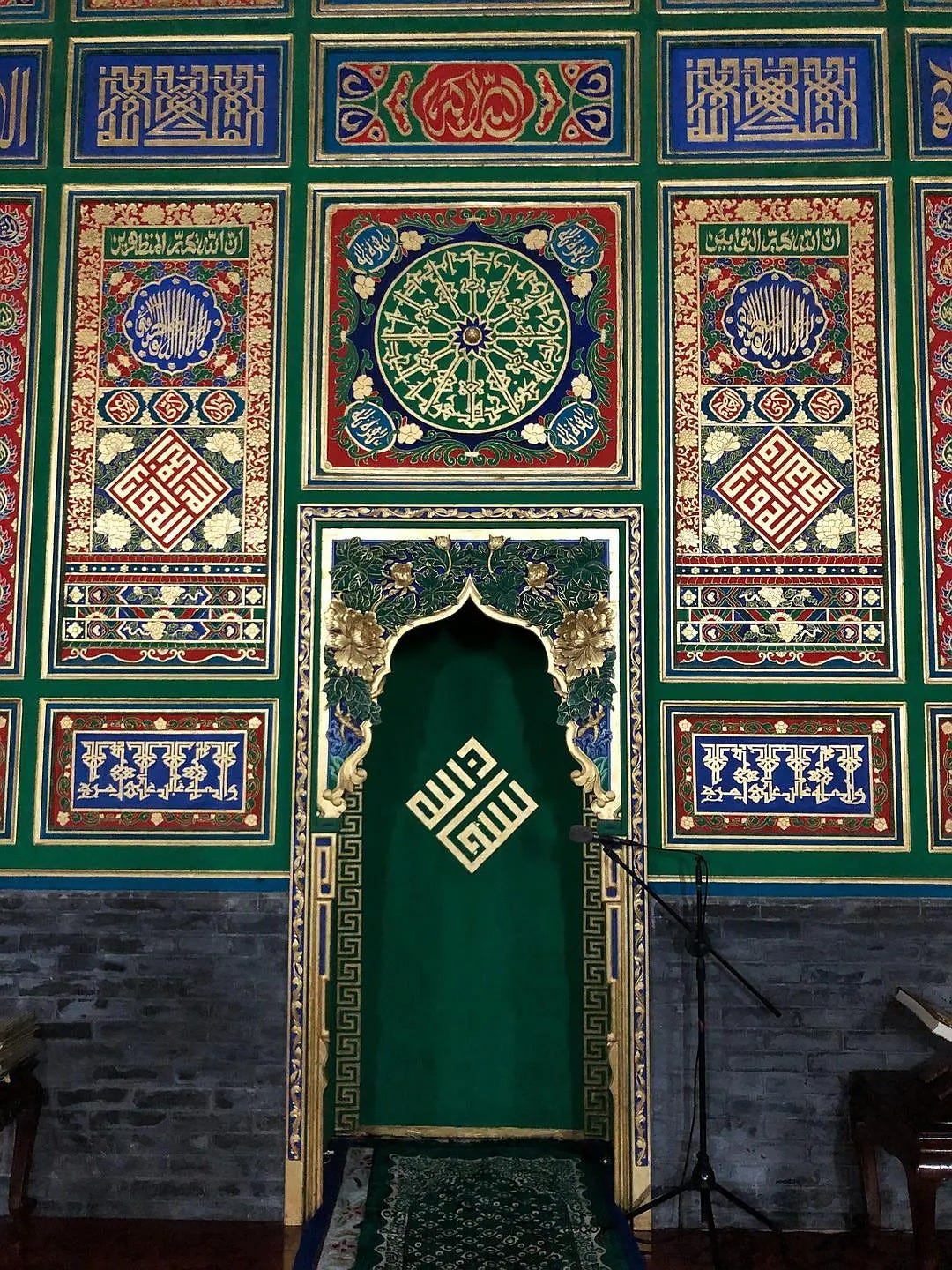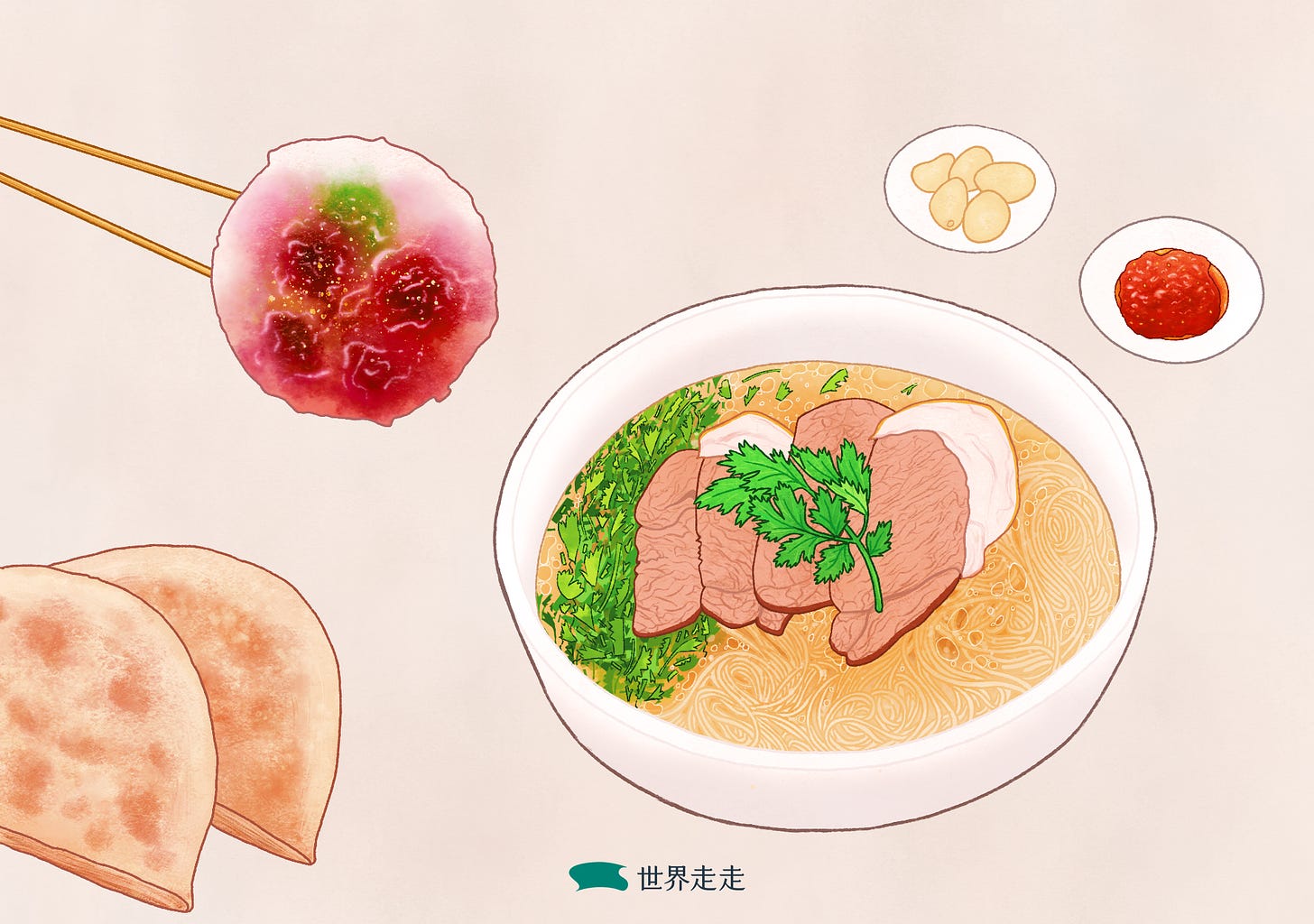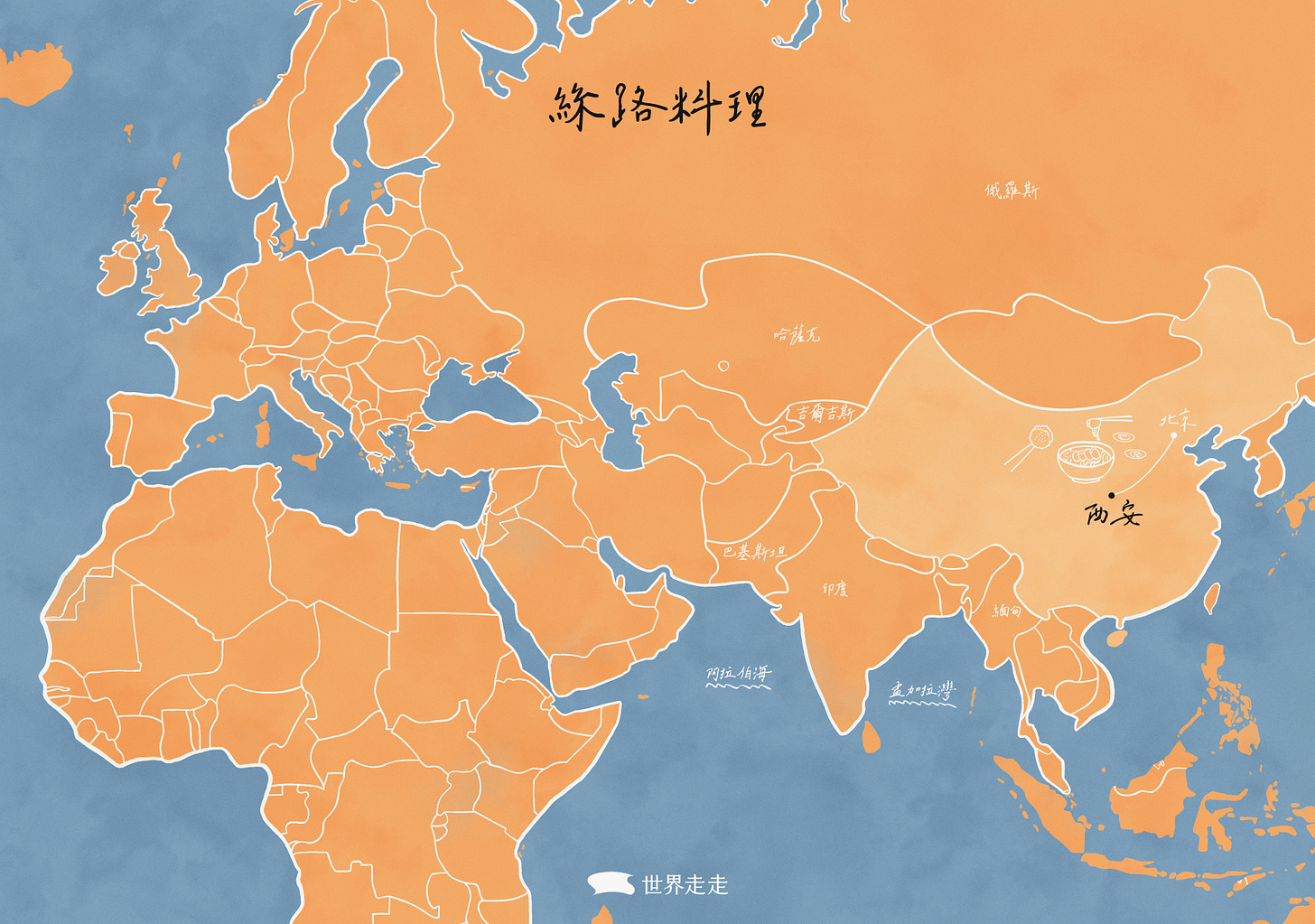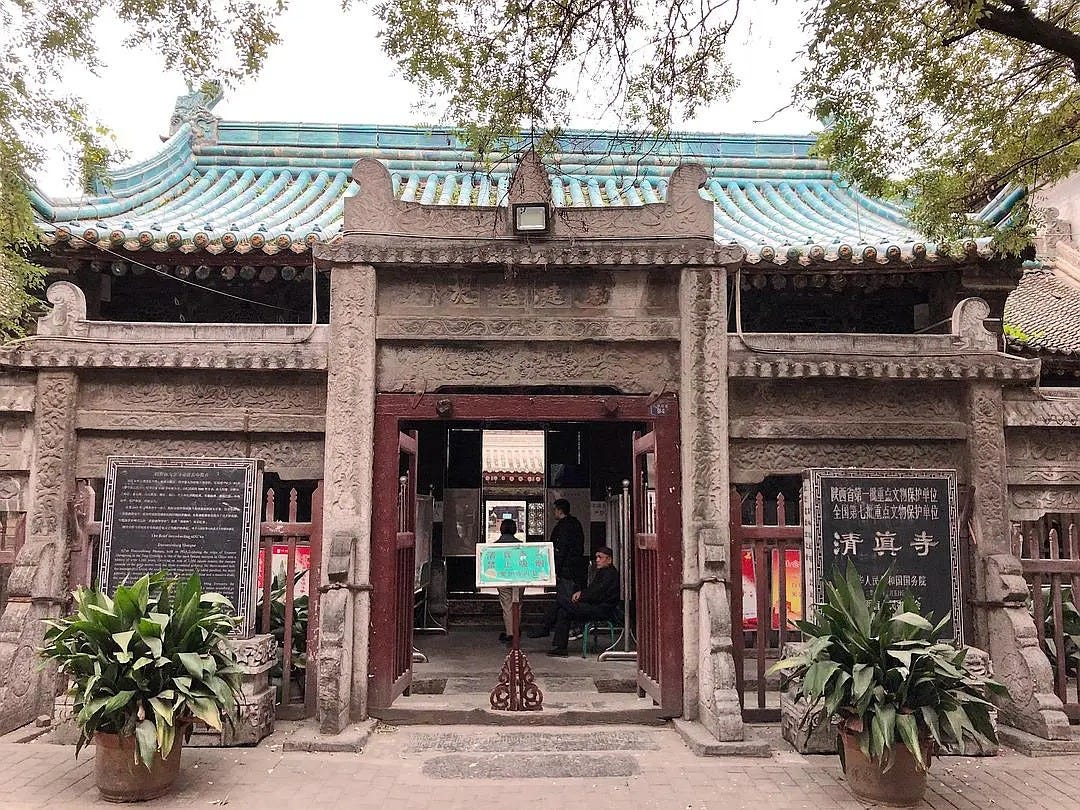-
[Silk Road Cuisine] Series Column
Text / Mustafa
Xi’an City.
Since Beijing’s towering and imposing city gates, towers, and city walls were ruthlessly demolished piece by piece in the 1950s and 1960s. If you want to appreciate the appearance of the Ming Dynasty city walls, Xi’an City is probably one of the few choices. Because of retaining the city wall, my love for Xi’an is naturally even more.
For many people, the city of Xi’an is the Terracotta Warriors and the Huaqing Pool, but the reason why I love it is because it not only has various wonderful ancient relics, but also has the only one of the Tang Dynasty Jiaofang system that has survived to this day and is still populated by old residents. An area still called “fang”.
Seven Temples and Thirteen Squares
General travel programs and foreign teachers always refer to Huifang in Xi’an as “Muslim Street”. In fact, this is an inappropriate name for the locals. This is far more than one street. It is not the same “food street”, but a “square”.
The predecessor of Xi’an was Chang’an City in the Tang Dynasty. The early Tang Dynasty was also a period of fundamental transformation of the entire Eurasian continent. The Muslims who emerged from the Arabian Peninsula miraculously changed the face of the world rapidly. rooted. With the gradual Islamization of the Khurasan-Transoxania region, the Tang Empire also continued to have deeper contacts with Muslims. Since the establishment of official records of diplomatic relations in the second year of Tang Yonghui (AD 651), some Muslims have settled in Fanfang in Chang’an City. Until the mid-Qing Dynasty, the Muslim settlement in Xi’an City had formed the pattern of “seven temples and thirteen squares” that people call today, and this pattern has continued to this day. The united Xi’an Muslims are still unyieldingly protecting this precious settlement from being deliberately scattered.
The so-called “Seven Temples and Thirteen Squares” means that there are seven mosques and thirteen neighborhoods here. The old residents in Xi’an will call this place “Fangshang”: “Return to Fangshang”, which means coming here.
The World Walk has important stories you haven’t read yet. We focus on global issues from a gender perspective, complementing stories of dilemma, breakthrough, connection, and change that traditional power perspectives ignore.
Please pay a subscription to become our partner and walk with women around the world.
Lamb in a Basin
Walking here, I always regret that I ate too much last meal, and I can’t eat anything else, or I regret why I don’t have two stomachs. Of course, this is just a joke, and the meaning of returning to the workshop is far more than just food. But you have to admit that the first impression when you come here is the colorful guise of flags, store signboards, and one after another shouting and hawking. I have never walked a full street on Huifang on an empty stomach. There are so many delicious things to eat here.
But there are two things, one big and one small, that I always remember, one is the mutton in the water basin, and the other is the rose mirror cake.
What is water basin mutton?
As the name suggests, the mutton in the water basin is a heart-warming dish with meat, soup, and fans at the bottom. There is such a restaurant on Xu Shimiao Street not far from the Muslim Beida Temple (Xiaopiyuan), and the signatures in it are the steamed buns and the mutton in the water basin. Water basin mutton is a mutton dish in clear soup. Some people also like to make it with beef, which is water basin beef. It is mainly meat, water, a few simple spices, and then eaten with staple foods such as bread.
From the perspective of cooking principle, it is a similar cooking method in the middle part of Eurasia (about eastern Persia, Central Asia to Shaanxi, Gansu and Qinghai). I will also write about the shurpa of the Uyghurs, Uzbeks and other ethnic groups in Central Asia, as well as the abgoosht of the Iranians or the piti of Azerbaijan. The production principles of these dishes are all the same, but some local ingredients are different. , very interesting. From this, it can also be seen that people in various parts of Eurasia have a longer cultural commonality under the boundaries of the nation-state.
How to eat water basin mutton?
A bowl of mutton in a water basin is placed in front of you. First, see if there are three characteristics: clear soup, sliced or shredded meat, and crescent moon cakes on another plate. People in the northwestern provinces of China have long been accustomed to eating pasta, such as steamed buns and cakes. Although some stores do not provide crescent cakes, they must also have round buns. The general restaurant table will also prepare garlic, candied garlic and oily spicy seeds. When you eat mutton in a water basin, you usually have to drink a few mouthfuls of clear soup to experience the mellow soup, and then add some oily and spicy seeds. You Po La Zi is a chili sauce that can be seen everywhere in the northwestern provinces of China. Its biggest feature is that it looks red and shiny. It looks really scary, but it is fragrant and not spicy, and there are sesame seeds floating on it. In the soup, it is still cold skin, and the beef noodles are all delicious.
After drinking the soup, eating the meat, and then shredding the crescent moon cake and soaking it in the soup to eat. Or tear the middle of the crescent moon cake and fill it with meat, like a pocket cake or roujiamo. A bowl of soup is full of aroma in both smell and taste.
It is worth mentioning that in the process of making this dish, only a few simple spices are usually added, such as cumin, peppercorns, cinnamon, grass fruit (black cardamom), and a little white pepper is sprinkled when serving. pink. The smell of spices must not be too heavy, overpowering the deliciousness of the mutton itself.
Many people around me have less exposure to Eurasian food and are more familiar with Indian and Pakistani cuisine. They think that beef and mutton dishes must have all kinds of spices to remove the smell of meat, but in fact, this is a huge misunderstanding. Perhaps in the South Asian subcontinent, because of the hot flashes, the human body needs spices to remove moisture (this is the same as Sichuan people eat a lot of chili peppers), so the diets of India and Pakistan will add all kinds of spices, which is a dietary therapy reasonable. However, in the dishes from northwest China to Central Asia, and even the Khorasan region, the use of spices is not particularly heavy. Because the quality of the meat is good, a few spices play the role of finishing touch, which is the best.
Because I like to eat, I often cook at home, and I like to invite friends and relatives to try the craft. They always ask me how to make halal dishes, where to buy spices, and what to do if I don’t know all kinds of spices. In fact, I think that as long as you really like it and want to eat and make it often, all kinds of spices can be bought in Taiwan today (only a few kinds are hard to find, but they are harmless). If you don’t make it often, or if you don’t want to be a chef, you only need to have a few basic spices at home, such as pepper, cumin, cumin, cinnamon, pepper and other essential spices at home, to deal with various kinds of eastern Eurasia. Food is enough. Others are actually icing on the cake.
rose mirror cake
After talking about the mutton in the water basin that can quickly fill the stomach and warm the body, I will mention another very inconspicuous snack that I like very much, called Rose Mirror Cake. In the workshop, this kind of snack is always sold by the hawker pushing the trolley. At a cheap price, you can eat the sweet taste, sticky texture and mouthful of rose fragrance.
Another reason why I want to introduce it specifically is because its two basic ingredients, rose sauce and glutinous rice, just represent the characteristics of Xi’an Hui people’s fusion of things and are a very representative snack.
First of all, roses are flowers and ingredients from the Western Regions. In desserts in the Muslim world, rose water is almost indispensable. In Ming Dynasty, Ma Huan’s voyage notes “Yingya Shenglan” and Fei Xin’s “Xingcha Shenglan” both recorded rose dew produced in West Asian countries (Persian transliteration is gulab, and Chinese works in the Ming and Qing dynasties are also transliterated. “Guru” water), which refers to today’s rose water, is a transparent liquid extracted from roses, completely natural, with a rose aroma, which can be added to desserts to increase the aroma of roses, or sprayed on the body Or as a natural fragrance on your hair. In addition, rose sauce is also an important dessert in Muslim areas, and the roses from Damascus are world-famous roses.
Another ingredient of Mirror Cake is glutinous rice, which is very common in the southeastern provinces of China. In the north, we call it “jiangmi”. The sticky and glutinous texture obtained by steaming is very popular, and it is a common dessert ingredient in North and South China.
Since ancient times, the area of Shaanxi has been a gathering place for business travelers from east and west, so it is not unexpected that the Hui people here have skillfully combined these two ingredients to create this snack.
In Huifang, it is common to see hawkers use a special steamer to make rose mirror cake. It has many layers, like a cabinet with many layers of drawers. Each drawer is opened with a special wooden mold. Put the Jiang Mi noodles in it, insert two bamboo sticks, and pick up the bamboo sticks after steaming. In addition, there are more complicated ones, including nuts, sesame seeds, preserved fruits, etc., which are called “Eight Treasures Rose Mirror Cake”.
This is a common snack in Huifang. It is sticky and glutinous, with the fragrance of roses and rice, which is really endearing.
China Unicom on the Silk Road
As an important city on the ancient Eurasian trade network, Xi’an’s food, especially halal food, clearly reflects the connectivity characteristics of this “Silk Road”. The concept and ingredients of cooking have the color of the intersection of the East and the West.
This feature is also reflected in the buildings on Huifang. In the statement of “seven temples and thirteen workshops” mentioned above to describe Huifang, seven temples refer to seven buildings, and thirteen workshops are the approximate area. The seven buildings are seven ancient and precious mosques. At the end of the nineteenth century (the twelfth year of Guangxu), an Islamic scholar from Gansu, Ma Wanfu, went to Mecca for a pilgrimage and stayed there to study. After returning to China, he brought innovative ideas and was called the Ikhwani school. At the beginning of the Republic of China, Ikhwani thought had great influence among Chinese Muslim intellectuals, and its teaching activities were also introduced into Huifang, and new Mosque Middle Temple and West Temple were built. Just seven, but nine mosques.
Among these mosques, Huajuexiang Mosque may be regarded as a world-famous ancient mosque. As long as Chinese Islam is mentioned, this ancient mosque is always mentioned. But what I want to mention here is the Xiaopiyuan Mosque (also called Beida Mosque), which is relatively unknown to outsiders. His architecture is extremely beautiful, and there are witnesses to important historical events in recent times.

After the Second Opium War in 1900, the Eight-Power Allied Forces had invaded Beijing. The Empress Dowager Cixi and Emperor Guangxu fled all the way to Xi’an under the escort of Ma Fuxiang, so they also left a handwritten plaque in this mosque. During the Second World War, the Japanese bombed Xi’an, and the bomb dropped on the mosque hall miraculously did not explode, and the mosque was not blown to ashes like a god. During the catastrophe of the Cultural Revolution, the mosque on Huifang was severely damaged, and this mosque was no exception. Most of the cultural relics and buildings in the mosque were smashed, and the main hall was lucky to escape.
Since the 1980s, the Muslims on the Huifang have worked tirelessly and generously to start the difficult reconstruction work that lasted for two decades. With the efforts and protection of Muslims of all ages, this ancient mosque, which was built in the 14th century and at the beginning of the 17th century (rebuilt in 1611), can have its complete appearance today.
I have worshipped, prayed, and watched in condolences in this mosque. I saw the well-maintained and shiny interior paintings and Chinese and Arabic calligraphy. I was especially moved. A mosque has gone through so many hardships and trials in history. , it is not easy to pass on to today. It is like a microcosm of the journey of the Chinese Muslim community in this land. These people, for different reasons, whether in trans-Eurasian trade activities, diplomatic activities, expeditions, flight, or active or passive, in short, took root in this land, sprouted, and scattered leaves. (Finish)
Home Kitchen Version of Rose Mirror Cake
Ingredients:
65g glutinous rice flour, 65g rice flour, water, rose sauce, honey (optional), chopped nuts (optional), chopped preserved fruit (optional)
practice:
1. Put the same amount of rice flour and glutinous rice flour into a bowl, mix well, steam in a steamer for half an hour.
2. Put the rice flour mixture into a small container, such as a small egg tart cup, add about 40cc of water to the small cup, and then steam.
3. After the steam is generated, wait for about 10 minutes.
4. Take out the small cup, insert a toothpick or a small fork, take out the mirror cake, and dip it in rose sauce.
Chef Mustapha’s Easy Basin Lamb
Ingredients
Boneless lamb, onion, ginger, cinnamon, herb/black cardamon, peppercorns, fennel seeds, coriander, green garlic
practice
1. Soak boneless mutton (I like to use fatter mutton hind leg) in water for about half an hour, and then pull out the blood.
2. Put cold water into the pot and bring the water to a boil. Clean up any foam that floats. If the meat is slaughtered halal, the meat tastes better, and there is less blood and scum.
3. Change a pot of water. Add onion, ginger, cinnamon, a sprig or two of black cardamom (grass fruit), and a handful of cumin.
4. Stew for an hour and a half, let it cool at room temperature, and put the meat in the refrigerator. Slice when eating. How much to eat and how much to cut. Soak some pepper water in boiling water or boiling soup.
5. Take a bowl of soup, add mung bean vermicelli and sliced meat, bring to a boil, add salt and white pepper, add pepper water. Prepare some parsley and green garlic and sprinkle them into the soup. This is a bowl of water basin lamb.
6. Serve with oily spicy seeds and noodles when serving.
 The full text is easy to read and share: a bowl of mutton in a water basin, a piece of rose mirror cake, and a trip to the halal silk road
The full text is easy to read and share: a bowl of mutton in a water basin, a piece of rose mirror cake, and a trip to the halal silk road
About the Author| Mustafa (born and raised in Beijing, now living in Taiwan, amateur research on the material culture and collections of the Muslim world. Contact: [email protected])
Subscribe to the Walk Around Newsletter and we’ll deliver:
[Members only] Go original: a good story that others have not written yet
An Evening News Every Day: A selection of daily news summaries for you
Weekly Newsletter: Good articles from around the world that you may have missed
A Weekly Note: A Weekly Guide to Online Activities
【Exclusive benefits for other members】» See here
This article is reprinted from: https://sehseh.substack.com/p/b61
This site is for inclusion only, and the copyright belongs to the original author.


